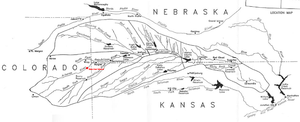
Back Bataille de Beecher Island French Slach by Beecher Island Frisian Битва на Бичер-Айленд Russian
| Battle of Beecher Island | |||||||
|---|---|---|---|---|---|---|---|
| Part of the Comanche War, American Indian Wars | |||||||
 A map of the Republican River and its tributaries, with the location of Beecher Island highlighted in red. | |||||||
| |||||||
| Belligerents | |||||||
|
|
Arapaho Cheyenne Sioux | ||||||
| Commanders and leaders | |||||||
|
J. H. Mooers, Surgeon† | Roman Nose† | ||||||
| Strength | |||||||
| 50 civilian scouts | 200–1,000 warriors | ||||||
| Casualties and losses | |||||||
|
6 killed 15 wounded[1] | 9–32 killed[2] | ||||||
Location within Colorado | |||||||
The Battle of Beecher Island, also known as the Battle of Arikaree Fork, was an armed conflict between several of the Plains Native American tribes and Forsyth's Scouts, a company of selected civilian frontiersmen, recruited and commanded by Brevet-Colonel George Alexander Forsyth. The battle occurred in late September 1868 with Forsyth and the scouts making a stand at Beecher Island, on the Arikaree River, then known as part of the North Fork of the Republican River, near present-day Wray, Colorado, named afterwards for Lieutenant Fredrick H. Beecher, Forsyth's executive officer killed during the battle.
- ^ Cite error: The named reference
AMH14was invoked but never defined (see the help page). - ^ Dixon, David (1994). Hero of Beecher Island: The Life and Military Career of George A. Forsyth. University of Nebraska Press. p. 87. ISBN 0-8032-1700-5.
